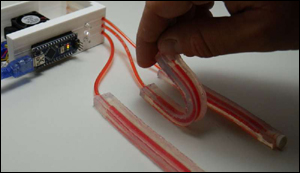A soft robotic skin based on liquid transmission
14. 6. 2019 | TechXplore | www.techxplore.com
Researchers at the Bristol Robotics Laboratory and the University of Bristol have recently developed a new soft robotic skin-like sensor that is based on fluidic transmission. This sensor, presented at the second IEEE International Conference on Soft Robotics (RoboSoft), could have interesting applications in a variety of fields, ranging from robotics to virtual reality (VR).
"Integrating sensors in robotic hands is a difficult task because often, we need to squeeze many components into a limited space," Gabor Soter, one of the researchers who carried out the study, told TechXplore. "Our idea was to transmit the sensory signals to other parts of the body, where there is more space for the sensing and processing hardware."

Skinflow, the sensor developed by Soter and his colleagues, is partly inspired by biological mechanisms observed in spiders. Spiders are able to transmit hydraulic pressure to different parts of their bodies for actuation purposes. In other words, they can generate pressure inside their bodies and transmit this energy to their legs in order to move them.
Read more at TechXplore
Image Credit: University of Bristol
-jk-




